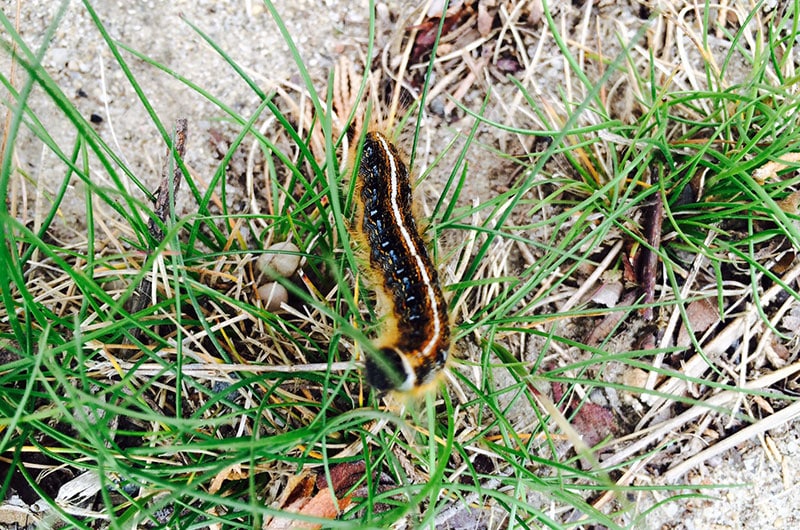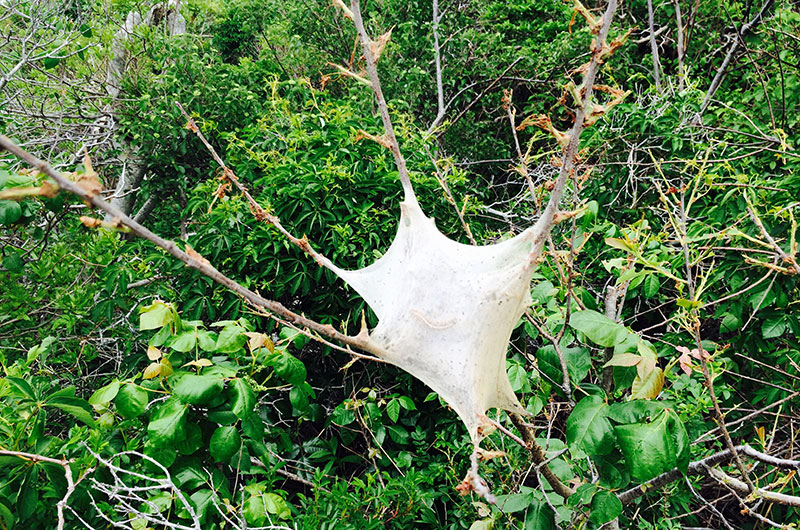• by Dr. Sarah D. Oktay – Director, University of Massachusetts Nantucket Field Station •

People really hate tent caterpillars. You’ll see folks removing the infected limb or using fire to kill the caterpillars inside. Even my husband, a lover of all natural things but especially fond of tart black cherries can be found removing the nests of these caterpillars by clipping off the tree limbs. Although tent caterpillars can severely defoliate a tree, they rarely kill it. If you saw the adult fluffy moth, you might feel a bit more empathy for this insect. The moth is reddish-brown with two pale stripes running diagonally across each forewing. Go to the handy dandy Bug guide site at http://bugguide.net/node/view/558/bgimage (retrieved May 30 2015) to see examples of the moth and the caterpillar.
The Eastern tent caterpillar (I’ll use the acronym ETC occasionally) oviposit (lay their eggs) almost exclusively on trees in the plant family Rosaceae, with a preference for cherry (Prunus) and apple (Malus) trees. The adult moth lays her eggs in a single batch in summer, typically in late June or early July depending on the latitude and location. The egg masses contain on average 150-300 eggs. These masses are covered with a shiny, black varnish-like material and encircle branches that are pencil-size or smaller in diameter. There is only one generation (egg- caterpillar- pupa- adult) per year. Embryogenesis (formation and development of the embryo) proceeds rapidly, and within three weeks, fully formed caterpillars can be found within the eggs. But the small caterpillars lie quietly until the following spring (this is called diapause), chewing their way through the shells of their eggs just as the buds of the host tree begin to expand.

These are some of the most advanced and social of caterpillars. They build their bags as a way to protect themselves, as a resting place, as a little “glass house” for basking, and as a home base for feeding, not unlike bee hives. This video http://www.youtube.com/watch?v=1qO6eCygcTE of ETCs coming in and out of their tent and expanding it while rapidly defoliating several tree limbs is extremely mesmerizing and also sad if you are a big fan of cherry trees. Since these guys are early spring caterpillars, they have some adaptations to the cooler weather. They can’t digest their food unless they are warm, so they huddle together at night for warmth, bask inside their tents in the day, and will wander about on the outside of the tent, sometimes stretching out and waving their hairs to cool down.
The caterpillars will feed three times a day, in early morning, midafternoon and in the early evening. Tent caterpillars secrete silk from a spinneret (similar to spiders) wherever they go and their frequently used pathways can be seen by obvious silk trails. As the caterpillars move about the tree, they largely confine their movements to these trails. The silk makes an easy to see their trails, but instead of using touch they use their sense of “smell” (olfactory chemoreceptors) as they follow a pheromone secreted from the posterior tip of their abdomen (insert sixth grade joke here). Caterpillars deposit exploratory trails by dragging the tip of their abdomen as they move over the tree in search of food. Caterpillars that find food and feed re-mark the exploratory trails they follow back to the tent, creating recruitment trails. Recruitment trails are much more attractive to the caterpillars than exploratory trails and they serve to lead hungry caterpillars directly to the newest food finds. It is possible for a single successful forager to recruit the entire colony to its food source which is awfully nice of it to do all the work (from http://www.citizendia.org/Eastern_tent_caterpillar retrieved May 30, 2015.) None of this is all that difficult considering their home is right on the food source we nice tender cherry buds and soft leaves at the end of each limb.
These caterpillars are very pretty, overall hairy with areas of blue, white, black (dominant color) and orange. I was enthralled to learn that the blue and white colors you see on an eastern tent caterpillar are structural coloration, not pigments. They use tiny microtubules to fool our eyes into seeing blue and white by selectively filtering light. Many colorful creatures such as peacocks and hummingbirds and butterflies incorporate structural coloration to ward off predators, attract mates, or simply look fabulous with a flexible wardrobe.
Tent caterpillars, like many other species of social caterpillars, vigorously thrash the anterior part of their bodies when they detect predators and parasitoids. With apologies to “Men Without Hats”, it’s literally a “safety dance”! They may do this either inside or outside of the tent, kind of like a caterpillar dance party. This can be extremely creepy. Such bouts of thrashing, which may be initiated by a single caterpillar, radiate rapidly though the colony and may result in group displays involving dozens of caterpillars. Such displays create a moving target for tachinid flies, wasps and other small parasitoids that lay their eggs on or in the body of the caterpillar. They also clearly deter stink bugs and other timid predators. Groups of caterpillars resting on the surface of the tent constitute aposematic displays, which is a fancy way of saying they display warning colors. Few birds other than the cuckoo find the hairy caterpillars palatable although many birds eat the adult moths. One of the reasons that the caterpillars are rarely eaten (and therefore more obvious to us) is that they often feed on the leaves of the cherry tree which are cyanogenic (contain a poisonous cyanide compound). The caterpillars will regurgitate cyanide-laden juices when disturbed and nothing is more disturbing than being eaten.
After the feeding and dancing and basking, when they are full-grown, larvae leave the host trees and disperse to form loose cocoons in protected places where they pupate. The adult moths (imagos) emerge about two weeks later. They are strictly nocturnal and start flying after nightfall, stopping to hang out and rest a few hours before dawn. Mating and oviposition typically occur on the same day the moths emerge from their cocoons; the females die soon thereafter (sad) with an average life span of five days for the moths. If it is any consolation (obviously not for the moth), the Infestations tend to be cyclic in severity, worsening for several years until their populations crash to low levels, then slowly rebuild. Most of the academic sites I visited list an 8-10 year cycle.
The eastern tent caterpillar is often confused with several other caterpillar species; the forest tent caterpillar, fall webworm, and the bagworm. And visions of them tend to remind people of the gypsy moth invasions several decades ago. Gypsy moths look different from eastern tent caterpillars; the gypsy moth has 5 pairs of blue spots near its head and 6 pairs of red spots from their midpoint to their tail. This excellent Cornell web site http://www.nysipm.cornell.edu/ornamentals/Eastern_tent_caterpillar.asp tells us more about the range and impact of eastern tent caterpillars. As bad as the damage looks, ETC rarely kill the trees they are defoliating. From the Penn State College of Agricultural Science Entomology Department: “When caterpillars are abundant, they frequently eat all the leaves on a tree which weakens it, but seldom kills it. The foliage on the host tree may be stripped from all the twigs within a distance of three feet from the nest(s).” http://ento.psu.edu/extension/factsheets/eastern-tent-caterpillar retrieved May 30 2015.
Scientists and students at have been experimenting with lab populations of ETC to see if climate change is effecting them by causing cherry trees to develop leaves before the ETCs have emerged as caterpillars. From the two papers I scanned it looks like there are some concerns with the offset between emergence and budding, but different populations of ETC react differently and their ability to deal with cold weather and move forward into the season may save them. More at http://eco.confex.com/eco/2014/webprogram/Paper47529.html and http://deepblue.lib.umich.edu/handle/2027.42/61464
I hope all this info make you detest these guys less. I have met people who are petrified of them and their handiwork is alarming, but healthy fruit trees will survive and they are providing food for other things. Their intricate and socialized survival techniques imply that Eastern tent caterpillars will stick around for a while. And speaking of social survival skills, nature walks now are being held Monday-Friday at the UMass Boston Nantucket Field Station at 180 Polpis Road at 10:00 am. Call 508-228-5268 for more information.


